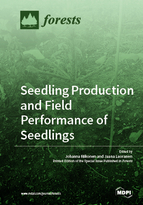Seedling Production and Field Performance of Seedlings
A special issue of Forests (ISSN 1999-4907). This special issue belongs to the section "Forest Ecophysiology and Biology".
Deadline for manuscript submissions: closed (31 March 2018) | Viewed by 58439
Special Issue Editors
Interests: forest tree species; LED lighting; nursery production; photobiology; plant physiology; year-round seedling production
Special Issues, Collections and Topics in MDPI journals
Interests: tree seedling production and forest regeneration, especially planting dates; frost hardiness of tree seedlings; mechanized planting and its biological basics; pine weevil damage and regeneration methods
Special Issue Information
Dear Colleagues,
Rapid establishment of seedlings in forest regeneration or afforestation sites after planting is a prerequisite for a successful reforestation. Seedling survival after outplanting can be improved by using high-quality seedling material. Seedling quality consists of several features, such as genetic source, morphological properties, nutritional status, stress resistance, and vitality of the seedlings. Field performance of the seedlings is a complex process, which can be affected by many nursery and silvicultural practices. Nursery cultural practices strongly affect the seedling quality that is generally at the highest level during the growth period at the nursery. Afterwards, when the seedlings are transported from the nursery to the planting site (including seedling storage, handling, shipping, and planting practices), quality of the seedlings can only remain the same or decline. For ensuring a successful regeneration, it is important to produce seedlings that retain their high quality until planting and to establish them quickly in the forest regeneration site.
This Special Issue of Forests is focused on seedling quality, and how it can be manipulated in a nursery, and how the quality of the seedlings affect their field performance after planting. Research articles may focus on any aspect of seedling production of forest tree species, including interactive effects of nursery cultural practices and field site conditions, including manipulation treatments (e.g., soil preparation), on the field performance of seedlings. Studies dealing with the effects of nursery practices on the ability of seedlings to sustain stressful conditions better, from a nursery to the reforestation site, are also welcome.
Dr. Johanna Riikonen
Dr. Jaana Luoranen
Guest Editors
Manuscript Submission Information
Manuscripts should be submitted online at www.mdpi.com by registering and logging in to this website. Once you are registered, click here to go to the submission form. Manuscripts can be submitted until the deadline. All submissions that pass pre-check are peer-reviewed. Accepted papers will be published continuously in the journal (as soon as accepted) and will be listed together on the special issue website. Research articles, review articles as well as short communications are invited. For planned papers, a title and short abstract (about 100 words) can be sent to the Editorial Office for announcement on this website.
Submitted manuscripts should not have been published previously, nor be under consideration for publication elsewhere (except conference proceedings papers). All manuscripts are thoroughly refereed through a single-blind peer-review process. A guide for authors and other relevant information for submission of manuscripts is available on the Instructions for Authors page. Forests is an international peer-reviewed open access monthly journal published by MDPI.
Please visit the Instructions for Authors page before submitting a manuscript. The Article Processing Charge (APC) for publication in this open access journal is 2600 CHF (Swiss Francs). Submitted papers should be well formatted and use good English. Authors may use MDPI's English editing service prior to publication or during author revisions.
Keywords
- Tree seedling
- Nursery production
- Cultural practice
- Seedling quality
- Field performance







